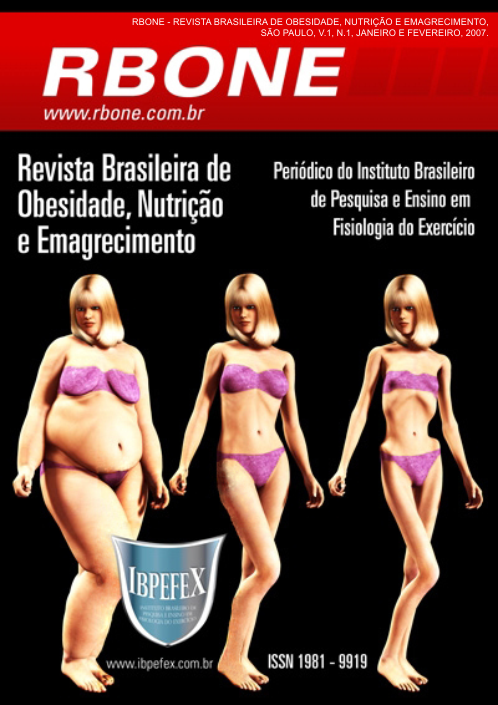Relation of sensitivity to Phenylthiocarbamine (PTC) and the nutritional state of the patients taken care of in centers of health of Brasília-DF
Abstract
Treatment for obesity and its comorbidities can be more effective with the findings of new alternatives in nutritional therapy. Studies providing evidence that connect test and eating preferences if individual genetics are important for finding new treatments. The purpose of this study is to assess the connection between phenylthiocarbamide sensibility and the patients’ nutritional state. Methodology: A case-control study was carried out with 94 patients. Each subject underwent two phases: nutritional assessment and phenylthio-carbamide sensibility test. Results: In what regards the nutritional profile, 39.4% were included in the case group (overweight/obese) and 60.6% in the control group (eutrophic). HDL was the only altered biochemical datum that had a significant prevalence on PTC-sensitive subjects in comparison to insensitive subjects (p≥0.014). The test threshold was solution 8 for both groups, taking into account that 19.1% are insensitive. Phenylthio-carbamide perception presented significant relation to the nutritional state (p≥0.036), and when it was associated to gender, there was a significant difference for male subjects (p≥0.008). Conclusion: phenylthiocarbamide sensibility may influence the nutritional state of individuals, especially when it concerns male individuals.
References
- Anliker, J.A; Bartishuk, L; Ferris, A.M; Hooks, L.D. Children ́s food preferences and genetic sensitivity to the bitter taste of 6-n-propylthiouracil (PROP). Am Journak Clin Nutr, 1991; 54:316-20.
- Bartoshuk, L.M. Separate worlds of taste. Psychology Today. 1980; 14(4): 48-63.
- Bartoshuk, L.M.; Duffy, V.B.; Miller, I.J. PTC/PROP Tasting: Anatomy, Psychophysics, and Sex Effects. Psychology & Behavior, 1994; vol. 56, n. 6, 1165-1171
- Beiguelman, B. Taste sensitivity to phenylthiourea and leprosy. Acta Genet. Med. Gemellol. 1964.13: 193-196.
- Beiguelman, B.; Ramalho, A.S.; Arena, J.F.P. e Garlipp, C.R. A acetilação da isoniazida em brasileiros caucasóides e negróides com tuberculose pulmonar. Rev. Paul. Med.1977 89: 12-15.
- Brasil. Ministério da Saúde. Instituto Nacional de Alimentação e Nutrição. Coordenação de orientação alimentar. Obesidade e desnutrição. 2004.
- Cabral, P.C.; Melo, A.M.C.A.; Amado, T.C.F.; Santos, R.M.A.B. Avaliação antropométrica e dietética de hipertensos atendidos em ambulatório de um hospital universitário. 2003.Rev Nutr Campinas 16(1):61-71.
- Crook, C.K. Taste perception in the newborn infant. Infant Behav Dev, 1978; 1:52-69.
- Cuppari1 L. Nutrição Clinica no Adulto. Cap 07; editora Manole, SP, 2002.
- Cuppari2 L. Nutrição Clinica no Adulto. Cap 05; editora Manole, SP, 2002
- Drewnowski, A.; Henderson, S.A.; Barratt-Fornell, A. Genetic taste markers and food preferences. American Society for Pharmacology and Experimental Therapeutics, 2001. Vol. 29:535-538.
- Drewnowski, A. Genetic taste markers and preferences for vegetables and fruit of female breast care patients. Journal of the American Dietetic Association, fev. 2000, vol. 100 nº. 2, pg 191-197.
- Drewnowski, A. Taste preferences and food intake. human nutrition program.School of health, the University of Michigan, Annu Rev Nutr. 1997.17:26 237-253.
- Duffy, V.B.; Bartoshuk, L.M. Food acceptance and genetic variation in taste. J Am Diet Assoc, 2000;100:647-655.
- Duffy, V.B.; Peterson, J.M.; Bartoshuk, L.M. Associations between taste genetics, oral sensation and alcohol intake. Physiology & Behavior. 2004; 82:435-445.
- Filho, J.F. A Prática da Avaliação Física. 2 edição. Editora Shape. 2003.
- Gretchen, L.; Goldstein, G.L.; Daun, H.; Tepper, B. J. Adiposity in Middle-aged Women is Associated with Genetic Taste Blindness to 6-n-Propylthiouracil. Obesity Research. 2005. Vol. 13, No. 6.
- Heitmann, B.L.; Harris, J.R.; Lissner, L.; Pedersen, N.L. Genetic effects on weight change and food intake in Swedish adult twins. Am J Clin Nutr, 1999; 69:597–602.
- I Diretriz Brasileira de diagnóstico e tratamento da Síndrome Metabólica, 2005.
- Lima, C.P. Genética Humana. 2ª. Ed. São Paulo. Ed. Harba Harper & Row do Brasil. 1984. Cap 24.
- Ordovas, J.M. HDL genetics: candidate genes, genome wide sacns and gene environment interactions. Cardiovasc drugs ther. 2002;16:273-281.
- Parker, LA.; Doucet, K. The effects of nicotine and nicotine withdrawal on taste reactivity. Pharmacol Biochem Behav, 1995. 52(1): 125-9.
- Rozin, P.; Vollmecke, T.A. Food likes and dislikes. Annu Rev Nutri. 1986; 6:433-56.
- Souza, L.J.; Neto, C.G.; Chalita, F.E.B.; Reis, A.F.F.; Bastos, D.A.; Souto Filho, J.T.D.; Souza, T.F.; Côrtes, V.A. Prevalência de Obesidade e Fatores de Risco Cardiovascular em Campos, Rio de Janeiro. Arq Bras Endocrinol Metab.2003; vol. 47, nº 6.
- Whissell-Buechy, D.; Wills, C. Male and female correlations for taster (PTC) phenotypes and rate of adolescent development. Ann Hum Biol 1989; 16;131-46.
Authors who publish in this journal agree to the following terms:
- Authors retain the copyright and grant the journal the right of first publication, with work simultaneously licensed under the Creative Commons Attribution License BY-NC which allows the sharing of the work with acknowledgment of the authorship of the work and initial publication in this journal.
- Authors are authorized to enter into additional contracts separately for non-exclusive distribution of the version of the work published in this journal (eg, publishing in institutional repository or book chapter), with acknowledgment of authorship and initial publication in this journal.
- Authors are allowed and encouraged to post and distribute their work online (eg, in institutional repositories or on their personal page) at any point before or during the editorial process, as this can bring about productive change as well as increase impact and impact. citation of published work (See The Effect of Free Access).






